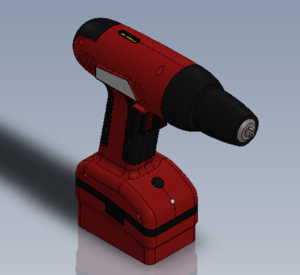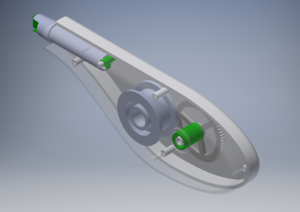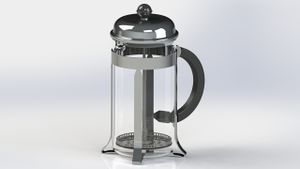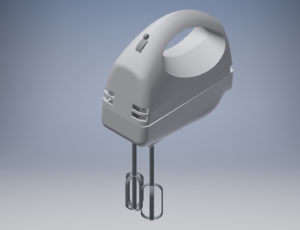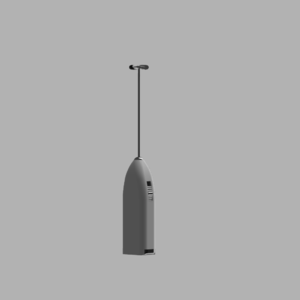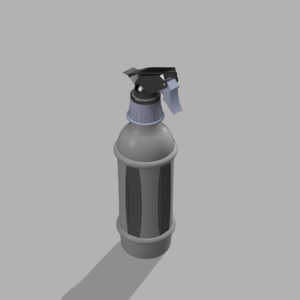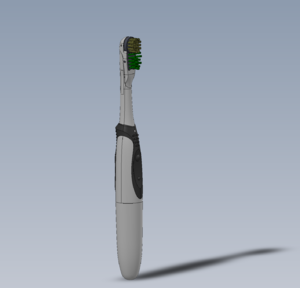Sandbox/Virtual Product Dissection
Objectives
The objective of this lab is to evaluate the functional design of a product and apply the discovered characteristics of that product to a new design. Product dissection is a type of reverse engineering that reveals how products work and can be used as a tool for design inspiration. The goal is to design an innovative water toy for use by kids ages 4-6. The toy must be safe to use and fun.
Overview
Product dissection is often done in industry and academia to uncover opportunities for re-design. Designers take apart and analyze all components of a product to understand its structure and properties. Through understanding the product, design opportunities can be uncovered and applied to the redesign of a product. Therefore, the goal of dissection is to improve the functionality, maintainability, and reliability of a product through the examination, study, capture, and modification of other existing products.[1]
Engineering Design Process
The engineering design process is a systematic approach to the collecting, analyzing, and decision making required to create a new product or service. There are a number of published engineering design processes, but the majority of them contain the same elements. As seen in Figure 1, the steps of the engineering design process include identifying the needs and assumptions, researching the problem, brainstorming, selecting a solution, prototyping, testing, and improving.

Product dissection is an important tool to inform decisions in the researching, imagining, and planning stages. In particular, the imagining step, also referred to as brainstorming or ideation, can benefit from taking the concepts of an alternative product and applying it to a new design. In this lab, it is also essential to ask about and identify the needs and constraints of the design. Future labs will cover the prototyping, testing, and redesigning steps.
Design Fixation
Design fixation is a problem that engineers and computer scientists experience when they have preconceived notions of or create an initial idea for a design and cannot conceive alternatives. Some methods to overcome design fixation include product dissection, design heuristics, SCAMPER, and brainstorming. Brainstorming is the idea generation that occurs during the conceptualization phase of the design process. Design heuristics and SCAMPER are methods that use modifying verbs to inspire alternative solutions. Product dissection uses the design characteristics of existing product s and applies them in a new context.
Reverse Engineering
Reverse engineering is the reproduction of a product's specification by the examination of the product's components and functionality. Hardware reverse engineering involves product to see how it works. For instance, if a processor manufacturer wants to see how a competitor's processor works, the company can purchase the processor, disassemble it, and then make a new processor similar to it. In some countries, this process is illegal. Hardware reverse engineering is quite expensive and requires an expert in the field.[3]
Software can also be reverse engineered. Reverse engineering software involves reversing a program's machine code to obtain the original source code or determine the file structures the program uses. This is done when source code is lost or is not available. For example, when a project is reactivated after being dormant for years to add new features to a product, the original design documentation may have been lost. Reverse engineering software to copy it constitutes a copyright violation and is illegal.[3]
Design Considerations
- Design an innovative water toy for use by kids ages 4-6.
- The toy must be safe to use and fun.
- Incoprorate the dissected product's design functional characteristics below:
- Power supply/energy source
- Primary motion
- Energy flow
- Form and outer body
Materials and Equipment
- Solidworks eDrawings
- Product dissection files
- Any materials needed for hypothetical design of a water toy
Procedure
Creativity during ideation (10 minutes)
The purpose of this introduction and discussion is to help students recognize the importance of creativity in engineering design and get them in the creative mindset. To start this section, the PowerPoint slides should be used to facilitate a discussion on the design process and idea generation. During the PowerPoint, students will watch a video. The purpose of this video is to provide students with a foundation of what it means to be creative during the idea generation process and what barriers exist to being creative. Ask everyone to take out a piece of paper and a pencil to compete the activity in the video.
After watching the video, students will take part in an energizing activity to get them into the creative spirit (and hopefully laughing while they do it). Students generally really enjoy these activities. Since this activity takes place in a computer classroom, where space is limited, this energizer does not require students to get up and move. Paper Clip Energizer
- Ask everyone to take out a piece of paper and a pencil
- Tell them to write down as many ways to use a paper clip as possible, give them a reasonable time limit (2 minutes)
- After the timer has gone off, ask students to count up how many ideas they had
- Ask for hands up for who had more than 5 ideas, then for 10+, then 15+, etc. At some point there should be only one student, ask them to read their list. (As they are the winner, feel free to give them a prize, such as a paper clip.)
- After the student has read their list, ask if anyone had any ideas that were not listed. Keep gathering ideas. Ask if any one came up with new ideas after people have read from their last.
- The goal is to get them in the creative mindset, and also let them know that working together can help spawn more ideas.
After completing the energizer an overview of different idea generation methods should be given, as laid out in the slides.
First idea generation session - Individual brainstorming (10 minutes)
The goal of this activity is to get students to put all of their current ideas down on paper. This session helps students to move on with new ideas in the next session and to identify how their ideas changed after the dissection activity. Students should perform this brainstorming session individually and should be introduced to the rules of brainstorming:
No (self) judgement • Encourage wild ideas • Stay focused on the topic • Be visual • Go for quantity • Combine & improve ideas
Product dissection overview (10 minutes)
The goal of this activities is to introduce students to product dissection as an idea generation method. Product dissection is often done in industry and academia to uncover opportunities for re-design and inspire new design ideas. The purpose of this activity is to allow students to take apart and analyze all components of a product to understand its structure and properties, and thus, find ways to improve the product and/or be inspired for new design ideas. This activity can help to improve the functionality, maintainability, and reliability of a product through the examination, study, capture, and modification of existing products. It can also help serve to inspire new design ideas by drawing inspiration from products in different design domains. Therefore, it is ideal that students dissect products outside of the area they are designing. Ex. If the task is to design a new electronic toothbrush, have the student dissect any product that is not a toothbrush! Students should take part in a discussion about product dissection and watch the short video on the website under the video tab
Product dissection activity (15 minutes)
After the discussion students should choose which products to dissect. At this point they should be given the product dissection handout. Deciding which product to dissect should be done in project groups, and each student should dissect something different from their teammates. The available product models can be found on the website under product models After students have chosen their products, students should watch the tutorial video for SolidWorks eDrawings
Second idea generation session (10 minutes)
This second idea generation session is intended to help students to build on ideas from their product dissection. Students should draw out specific design ideas on idea generation sheets. These ideas may stem from the application opportunity box from the previous activity or be completely new. Remind students that they should write out all ideas that are not currently on their idea generation sheets. Students should perform this idea generation session individually and should be reminded of the rules of brainstorming
Assignment
Individual Lab Report
The lab 1 report should only include content on Lab 1B Virtual Product Dissection. This means that Lab 1A Introduction to Microsoft Office and Lab 1C Introduction to 3D Printing should not appear in the lab report. For guidance on the first report, the assignment questions below have been organized into the sections in which they should appear in the report. On future lab reports, judgement must be used to determine which section of the report should address each question.
Follow the lab report guidelines laid out in the page Specifications for Writing Your Lab Reports in the Technical Communication section of this manual. The following discussion points should be addressed in the appropriate section of the lab report: Introduction
- Define product dissection.
- Define design fixation.
- Explain the engineering design process.
Procedures
Data/Observations
Discussion/Conclusions
- Describe how the product design changed from the beginning of dissection to after.
- During product ideation did design fixation impact any parts of the product? What negative impact did this have on the design?
Remember: Lab notes must be taken. Experimental details are easily forgotten unless written down. EG1004 Lab Notes Paper can be downloaded and printed from the EG1004 Website. Use the lab notes to write the Procedure section of the lab report. At the end of each lab, a TA will scan the lab notes and upload them to the Lab Documents section of the EG1004 Website. One point of extra credit is awarded if the lab notes are attached at the end of the lab report. Keeping careful notes is an essential component of all scientific practice.
Team PowerPoint Presentation
There is NO team presentation for Lab 1.
Footnotes
- ^ Starkey, E., Hunter, S., & Miller, S.Learning with Product Dissection. https://www.engr.psu.edu/productdissection/. Retrieved 2019. This work is supported by the National Science Foundation through grant number 14630009.
- ^ TeachEngineering. The Engineering Design Process. https://www.teachengineering.org/k12engineering/designprocess. Retrieved 2019. The source of this material is the TeachEngineering digital library collection at www.TeachEngineering.org. All rights reserved.
- ^ a b What Is website. TechTarget Network. https://searchsoftwarequality.techtarget.com/definition/reverse-engineering Retrieved July 29th, 2003.
| ||||||||
